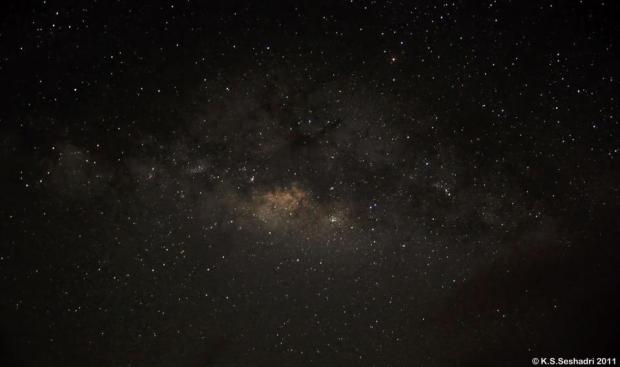
Photo: K.S. Seshadri / Research Matters
A protective sheath covering the earth, bombarding cosmic rays, violent storms in the upper atmosphere – these are not figments of imagination from a sci-fi novel but are rather accurate descriptions of the space surrounding the earth. In fact, the space around our planet is chock full of high energy particles whizzing around, like the solar wind, a steady stream of charged particles emanating from the sun and Galactic Cosmic Rays (GCR), ultra high energy particles of cosmic origins travelling at nearly the speed of light. Why then don’t we have to bother about the effects of such high energy particles that can affect our electronic gadgets and damage our DNA? The answer is the geomagnetic field, the magnetic field of the earth, extending from the core out into space a distance of several earth radii, forming a region around the earth called the magnetosphere.The GMF acts as our natural shield by deflecting high energy charged particles away from the earth.
However, an event of solar origin, called coronal mass ejection (CME) can interfere with the shielding ability of the GMF. Once in a while, a blob of plasma is thrown off from the active regions on the sun’s surface and travel outward through space. These ejections, called CMEshave significant magnetic fields of their own. If they happen to pass through the vicinity of our planet, strong interactions take place between the GMF and the CME field, just as two bar magnets brought close interact with each other, causing intense electromagnetic disturbances in earth’s atmosphere – events termed as geomagnetic storms. During such events, entryways are opened for cosmic rays to enter the atmosphere. These storms, apart from creating beautiful displays of light in the sky, called auroras, can also be harmful to the earth and its inhabitants. The electromagnetic disturbances caused in the ionosphere affect power grids on the ground, satellite hardware and radio and radar systems. Navigation systems like the GPS and the simple magnetic compass are rendered useless, while astronauts, devoid of the atmosphere’s protection, are at risk of radiation exposure.
Considering their impact, studying geomagnetic storms is undoubtedly imperative. Also important is the study of cosmic rays entering our atmosphere. While studying galactic cosmic rays afford us a glimpse into their sources outside our solar system and even beyond our galaxy, those of solar origin would let us learn more about our own star and the impact of its behaviour and processes on our planet. It is with these precise objectives that a state of the art research facility, the Gamma Ray Astronomy PeV Energies – phase 3 (GRAPES-3) was set up in the Cosmic ray Laboratory at Ooty in 2000 as a collaboration of the Tata Institute of Fundamental Research, Mumbai and the Osaka City University, Osaka, Japan. At present many institutions from India and Japan are in collaboration in this experiment that has generated significant results over the course of the past few years.
GRAPES-3 is all eyes and ears for subatomic energetic particles called muons. Muons form when nuclei of atoms in the upper atmosphere are bombarded by cosmic rays and can act as a proxy for the cosmic ray count. The huge 560 m2 area tracking muon detector, housed underground to filter out low energy particles, is the largest area tracking detector anywhere. The telescope measures muon intensity in nine independent directions and has a count rate of ~108 per hour. Also detected by the facility are air showers, the multitude of secondary particles formed due to the cosmic ray-nuclei collisions, cascading towards the earth. With 400 air shower detectors spread over an area of 25,000 m², GRAPES-3 array is the highest density air shower array in the world.
Recently, GRAPES-3 made news for having witnessed a breach in the magnetic shield of the earth. On the night of 22nd June 2015, a statistically significant surge in muon count, a burst of galactic cosmic rays entering the atmosphere, was observed for a duration of two hours, due to a transient weakening of the GMF. Earlier, on 21st June, the Solar and Heliospheric Observatory (SOHO) of NASA, positioned in space, photographed a CME erupting from the sunspot region NOAA 2371. 40 hours later, the CME reached the earth and the resulting interaction with the GMF caused a geomagnetic storm of severity 4 out of 5 on the National Oceanic and Atmospheric Administration (NOAA) scale.
The study by Prof. Sunil Gupta, senior professor at the Tata Institute of Fundamental Research (TIFR) and head of the Cosmic Ray Laboratory, and his team, which appeared in the October issue of Physical Review Lettersconcluded that a temporary reconfiguration of the earth’s magnetic field due to interaction with the passing CME had caused the observed GCR burst. The simultaneous occurrence of the burst in all nine directions suggested a source close to the earth, possibly inside the magnetosphere, marking the CME event as the prime suspect. Furthermore, experimental data shows that the burst was neatly correlated with the surge in the Interplanetary Magnetic Field (IMF) caused by the CME. Extensive simulations by the team have confirmed that a weakening of the GMF caused the surge in galactic cosmic ray intensity. “Discovery of this burst demonstrates that the weakening of earth’s magnetic field is an important condition in triggering a geomagnetic storm, and thus provides a firmer basis for understanding this complex phenomenon”, says Prof. Gupta about their discovery.
In the aftermath of this significant detection, apart from demonstrating the direct impact of space weather phenomena on earth’s magnetic field and consequently life on the planet, scientists propose monitoring of GCR intensity as an early warning system for an impending geomagnetic storm. “GCRs being high energy particles move at nearly the speed of light and can in principle complement the existing early warning system consisting of satellites located in space”, Prof. Gupta explained. Although implementation of this proposal would involve years of observation, studies and testing, the fact that a few hours of early warning can help prevent many of the debilitating effects of a storm is incentive enough for the scientists to further explore this possibility.
With these and more experiments in progress, The GRAPES-3 experiment continues being one of our most effective tools to study our own star, our planet’s magnetic shield and to unwrap more mysteries of the universe galactic cosmic rays bring with them.






